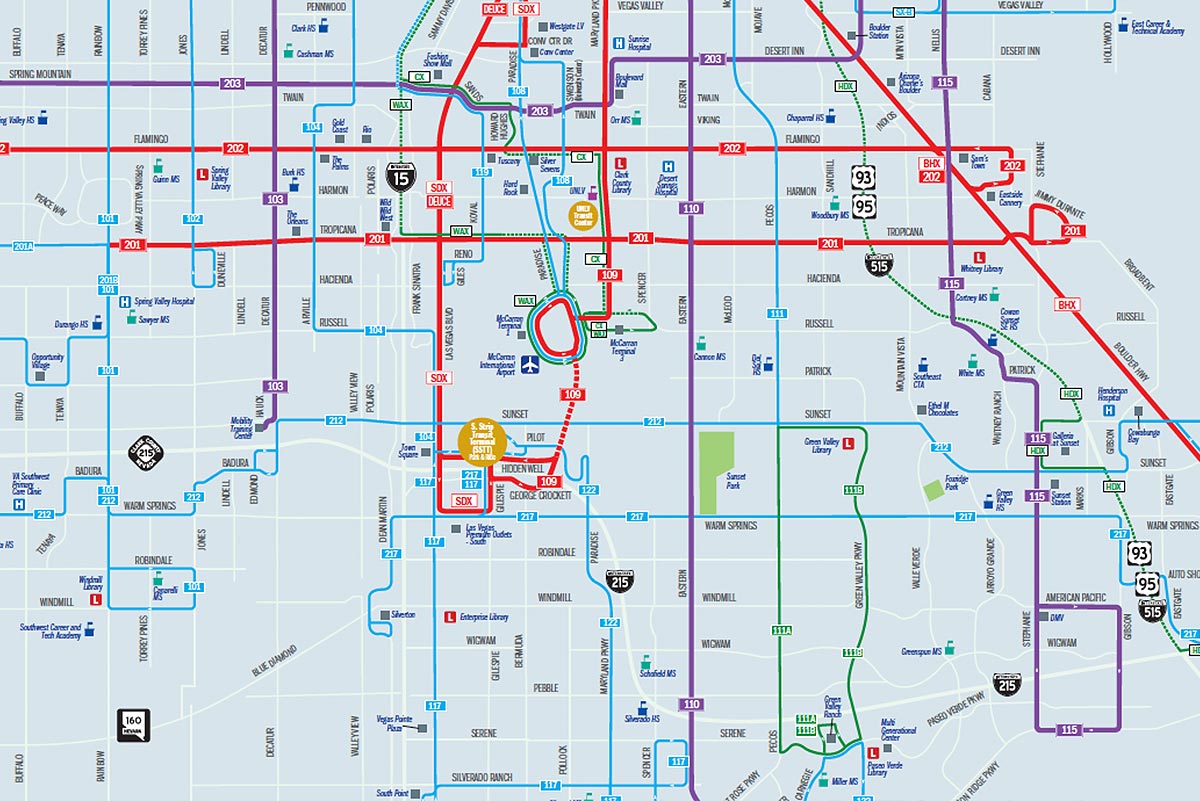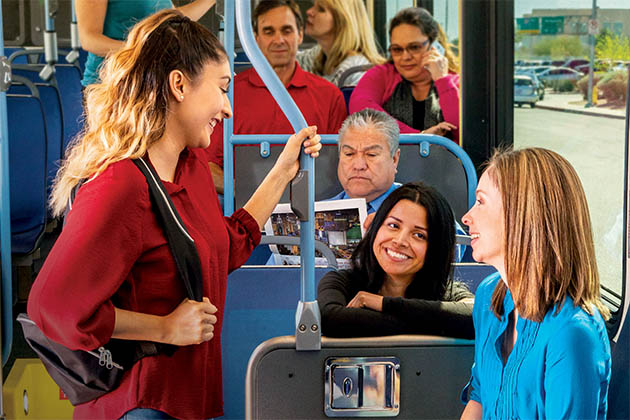Adaptive Signal Control Technology
Pilot Program
The RTC, together with the City of Henderson and Clark County, launched a smart adaptive traffic signal pilot program in Southern Nevada, along 14 intersections on Eastern Avenue between Beckler Drive and Pebble Road.
Instead of using traditionally timed traffic signals, adaptive signal control technology (ASCT) was deployed to determine if it can help make traffic signals more efficient and improve performance metrics, potentially resulting in:
- reduced traffic delays and congestion
- improved travel time reliability
- decreased vehicle emissions
- improved safety
Unlike traditionally timed traffic signals, signals with ASCT are supposed to react to changing traffic conditions caused by special events, road construction, and other roadway incidents to provide the best solutions to traffic signal phasing based in real time.


How do adaptive signals work?
First, strategically placed sensors collect data and feed this data into a controller to evaluate and develop signal timing improvements and modifications. Then, the adaptive signal control technology implements the signal timing updates. This process is continuously updated to ensure the signal timing is responding to real-time conditions on the roadway. In comparison, traditional signals require manual traffic counts and periodic timing adjustments.
Why Eastern Avenue?
The Eastern Avenue corridor from Beckler Drive to Pebble Road has 14 intersections. It consistently receives a high volume of traffic and connects to the I-215. The corridor generates high-peak traffic and complaints from drivers and pedestrians. This, along with its unique mix of residential and commercial uses, makes Eastern Avenue an ideal location to deploy and pilot ASCT in order to reduce congestion and improve driver and pedestrian experiences.
Unlike traditionally timed traffic signals, signals with ASCT react to changing traffic conditions caused by special events, road construction, and other roadway incidents to provide the best solutions to traffic signal phasing based in real time.
First, strategically placed sensors collect data and then evaluate that data to develop signal timing improvements and modifications. Then, the adaptive signal control technology implements the signal timing updates. This process is continuously updated to ensure the signal timing is responding to real-time conditions on the roadway. In comparison, traditional signals require manual traffic counts and periodic timing adjustments.
Adaptive signals can help make traffic signals more efficient and improve performance metrics, potentially resulting in:
- reduced traffic delays and congestion
- improved travel time reliability
- decreased vehicle emissions
- improved safety
This system utilizes artificial intelligence (AI) to determine the best times to turn traffic signals green. By adapting traffic to the demand moment-by-moment instead of relying on predetermined schedules, the system:
- increases safety
- reduces stop-and-go at intersections
- reduces traffic congestion
- decreases emissions
- reduces your travel time
The pilot will be implemented on 14 intersections along Eastern Avenue between Beckler Drive and Pebble Road.
The intersections include:
- Eastern and Pebble Road
- Eastern and westbound I-215 ramps
- Eastern and eastbound I-215 ramps
- Eastern and Serene Avenue
- Eastern and Richmar Avenue
- Eastern and Silverado Ranch Boulevard / Presque Isle Street
- Eastern and Ione Road
- Eastern and St. Rose Parkway
- Eastern and Siena Heights Drive
- Eastern and Coronado Center Drive
- Eastern and Horizon Ridge Parkway
- Eastern and Sunridge Heights Parkway
- Eastern and Summit Grove Drive
- Eastern and Beckler Drive
The Eastern Avenue corridor from Beckler Drive and Pebble Road has 14 signalized intersections. It consistently receive a high volume of traffic and connects to the I-215. The corridor generates high-peak traffic and complaints from drivers and pedestrians. This, along with its unique mix of residential and commercial uses, makes Eastern Avenue an ideal location to deploy ASCT in order to reduce congestion and improve driver and pedestrian experiences.
Some of the metrics we’ll be monitoring to determine success are:
- Reducing I-215 off-ramp queues backing up onto the freeway
- Reducing delays on side streets and left turns
- Reducing delays caused by emergency vehicle preemption
- Reducing the number of crashes
- Improving travel time
- Minimizing intersection exit blocking
The adaptive technologies typically uses sensors installed overhead to collect volume data on each approach of the intersection. The camera images are fed into a computer processor, which continually evaluates incoming data and changes the signal phases accordingly.
No. The sensors do not capture and store images or video, nor do they alert law enforcement of any violations. Traffic management personnel can log into the ASCT’s user interface to view each approach and intersection in real time and aid in emergency-dispatch situations or resolving complaints.
One of this system’s most valuable benefits is its ability to handle problems with hardware failure or a loss of communications. In the case where a camera feed stops functioning properly, the processor will rely on historical data to operate the traffic signals. The ASCT system will also automatically alert agency staff that a sensor has failed, and operators can log in remotely to look at the problem and in many cases, fix the issue remotely.
Motorists may notice a difference with the order of green phases at an intersection. This means that when a motorist is stopped at a red signal, instead of waiting for the entire cycle to complete, the ASCT will identify the best course of action and turn the signal green sooner than may be expected.
In order to activate pedestrian crossing, pedestrians must press the designated crossing button located at the corner of each intersection. Because pedestrians are prioritized when using ASCT, pedestrians may experience shorter wait times when crossing the street.
The system is connected to a VPN that is monitored by the agency system administrator. It is protected by a secure password and collects and stores data on the number of times the system is opened.
All traffic signals are timed with two goals in mind: 1) to make the traffic system as safe as possible for all users; and 2) to improve traffic flow. In Southern Nevada, our traffic signals typically operate under a semi-actuated coordinated schedule. Each traffic signal controller is programmed with different timing settings, depending on time of day (morning or afternoon rush hour) or according to what is happening at the intersection at that moment. Semi-actuated operation is used to provide progressive vehicle flow through a series of controlled intersections. Each intersection controller in the coordinated system operates within a common background cycle length.
Our signals today currently operate on a semi-actuated process that requires substantial amounts of manually collected traffic data to manage the coordinated schedules in a given corridor. The time-of-day signal timing plans accommodate minimal variable and unpredictable traffic demands. We are testing the adaptive signal technologies to react to changing traffic conditions in real time and adjust the signals accordingly. According to the Federal Highway Administration (FHWA) and several independent studies, adaptive signal technology can improve a signal’s performance.












































